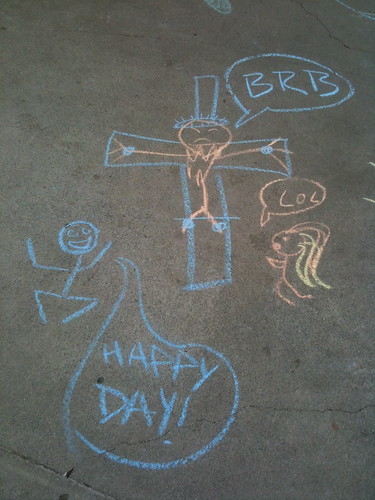This is coming way late, but I’ve been having some thoughts about xkcd’s Time comic percolating in my brain for a while. Because xkcd is a stick figure webcomic, the only gender cues available are longer hair on female characters or facial hair on male ones; characters’ genders are just not an issue, unless the storyline demands it. Women in the comic are just as nerdy and weird as men, and appear in about equal numbers overall—a couple times even outnumbering them. This is kind of a big deal, because I can’t think of any nominally gender-neutral media or space that regularly achieve that kind of parity, and makes it look so natural and normal. Which to me makes the comic a feminist one, though I don’t know if Randall Munroe would agree with that label.
In any case, I think I was primed to see the character dynamics in Time partly as some kind of statement. The story starts off with one male (let’s call him Y) and one female protagonist (let’s call her X), both interesting and nicely developed, and it seemed to me on first reading that X was more adventurous, more curious and a better scientist, and Y more passive. A third character they meet later on, a woman, is the leader of her community, which just seemed to confirm my first impression.
However, when I went back and reread it again some months later, I found the truth was a lot more nuanced. It looks like I was dealing either with confirmation bias—just a few frames stuck in my mind and coloured my entire memory of the story—or some kind of gender-based bias where a female character’s coolness jumps out at me more. Which is a weird one, and I don’t know if there’s a name for that.
For reference, here are the frames that stuck in my mind on first reading:
- He thought they couldn’t build their sand castle any taller, but she went and did it anyway. Not to show him up or anything, not to prove him wrong, but because it seemed like a fun thing to do.
- Maybe the one that jumped out at me the most, He shows a surprising lack of curiosity about the trees they encounter
- She jumps over the stream even though she’s injured and he offered to help.
- She thinks big, always pushing the limits of what’s possible.
But, there’s context for all of these, and they tell a somewhat different story. The trees, for instance: in the previous frame X has asked if the tree was supposed to be like that; i.e.: she was worried that it might be sick. So Y’s reply reads not so much as apathy, but rather trust that Nature generally knows what it’s doing. And, the belief that plants can be both weird-looking and healthy.
Overall I got the impression that Y has a very deep curiosity about the natural world. He loves to think about big and abstract things, like the sea, rivers, logic, and physics. His world is full of mysteries, which may someday be discovered, or maybe not—but the journey’s still worth it. He’s a big-picture kind of guy, less comfortable with living things or with nitty-gritty details. That’s more X’s department.
Where Y is mostly about theory, X is all about practice. She’s the hands-on engineering yang to his abstract yin—building sand castles, dreaming of building even bigger castles, easily excited about new technology and new shiny questions. Not the big questions Y likes, mind you, but specific, concrete, answerable questions. She’s brave and a bit reckless in the pursuit of those questions, but not so much that she doesn’t empathise with her companion and the cute little critters they meet.
I felt at first that X was the driving force behind their expedition, based (I think) on one frame where Y floats the idea of going home. But that comes after many lines of him thirsting for more understanding. But I guess everybody has limits. I’m also wondering if he gets antsier the further he gets from water?
More questions and not that many answers, but that’s okay. It was an interesting exercise in unbiasing myself, and—bonus!—I found a lot of beautiful places in re-exploring this amazing story. So it was totally worth it.


